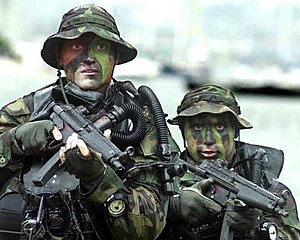Originally posted by Viking
GtoRA2, many armies use SMG's, especially those that still use battle rifles (like our army). The fact that everyone is using the 9 mm DOES mean it is good. Perhaps not the BEST, but definitely good. Saying that every army in the world are wrong and have been wrong for the better part of a century is beyond arrogant.
Modern 9 mm and .45 loads with advanced expanding bullets and over powered charges are completely irrelevant to this discussion. We are discussing military ball ammunition and preferably WWII vintage.

US Navy SEAL's with 9 mm MP-5 SMG's.
(only as a pistol round. I don't think most armies use SMGs for anything but to equip vehicle crews and some special forces under some conditions)
I will qoute myself to make things clear.
See, I said "Most armies" "Vehicle crews" and "some special forces under some conditions"
“Most armies” mean, well most, but not all, if I had meant ALL armies I would have said that, then you would have read it instead of pulling it out of your ass. Hell I could be wrong here as well, so let me amend, replace “most” with ”many” just to be safe.
I also have not said every army in the world is wrong. I am not an expert on the needs of anyone’s military including my own. I don’t think 9MM sub guns are bad weapons, though they are not going to be good at going through body armor. The 9MM round is fine, with that limitation in a machine gun because, well you shoot a guy with more then one round with a machine gun, hell if you need to you can shoot him 10 or 15 maybe even 20 rounds.
You can't do that with a pistol. Hell MOST WW2 9MM pistols didn't have more then 8 rounds making the 1911 the KING of WW2 handguns.
But that’s with the limitations of a handgun. I do not think I gave my opinion on what weapon I thought was better of the WW2 SMGs. If I had to I would say the Tommy gun, because most of the 9MMs were stamped steel and the Thompson wasn't.
Now I will admit, I didn't know there were still armies out there equipping infantry with SMGs other then I thought probably the Israelis did. That is interesting, why does your nation chose to do this? (honestly curious here, if you don’t want to pollute the thread more feel free to PM )
And on a final note, I did again say, “Some Special forces under some conditions”.
SEALs are indeed “special Forces” They do use SMGs under some conditions, so you were just illustrating my point for me? Or do you think they only use SMGs?